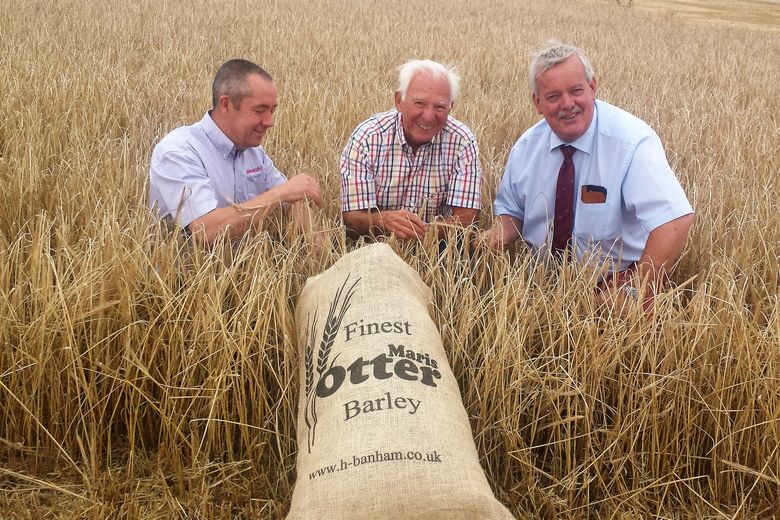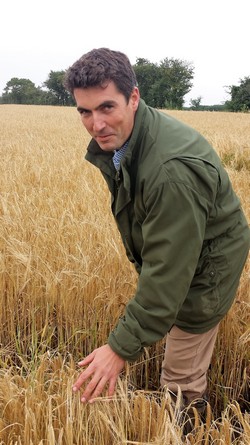
Mark and Tony Banham, of H Banham, with their Maris Otter grower of 50 years, Roger Coe
A year after its 50th anniversary, the Maris Otter malt variety has been showing its remarkable resilience after a poor growing season.
The weather has not been kind to this year’s winter barley crops. Mainstream varieties have taken something of a bashing. But North Norfolk’s Maris Otter crop has distinguished itself with what Tom Rivett (pictured below), of H Banham, describes as “its champion qualities.”
He said: “Despite the rain, lack of sunshine and challenging growing conditions, most of the Otter grains have reached optimum size and are, as always, perfect for malting and craft brewing. Looking at the state of the other crops, this is some achievement and [more] proof — if proof were needed — of Maris Otter’s trustworthy resilience.
 “What it lacks in yields, Otter more than makes up for in quality and reliability. That is the main reason it has survived an unprecedented 51 years. Most varieties last just four or five years before being superseded by new strains. Maris Otter, an ingredient in hundreds of award-winning ales as well as many champion beers of Britain, has literally weathered the storms for half a century.
“What it lacks in yields, Otter more than makes up for in quality and reliability. That is the main reason it has survived an unprecedented 51 years. Most varieties last just four or five years before being superseded by new strains. Maris Otter, an ingredient in hundreds of award-winning ales as well as many champion beers of Britain, has literally weathered the storms for half a century.
“It behaves well in the malting process, as the traditional floor maltings at Crisp Malting Group can testify. It is then sought after by an ever-increasing number of craft brewers. They swear by it, for its consistent performance in the mash tun and the depth of flavour it delivers to the beer. Even in the years of disappointing harvests, Maris Otter manages to hold on to its champion qualities.”
The huge expansion of the craft beer market, alongside the massive growth of interest in food, drink and natural ingredients, has heralded a renaissance in the fortunes of Maris Otter. It is still a specialist variety, making up a relatively small proportion of all the barley grown in Britain — just 2.6% in 2014 and 3.4% in 2015. Of barley that is malted and used for brewing, Maris Otter is a higher proportion, but still less than 10%.
Tom said: “Maris Otter hardly features in the world of large brewers, but it certainly punches above its weight in the craft sector. There may still be some way to go before this fantastic variety becomes a household name, in the way grape varieties such as Merlot, Shiraz and Chardonnay are, but awareness is growing.”
The variety is a cross, created from Pioneer and Proctor back in 1965, and its history is well worth exploring. It rose, declined and nearly died out in the 1990s but was rescued and revived by two grain merchants, H Banham and Robin Appel, who now jointly own the rights.
The revival involved starting afresh with just a few grains. The purest, most true-to-type Maris Otter seeds were picked out and used for propagation and onward breeding. To this day, there is still a secret plot where H Banham continues to carry out what must be one of the most regular and rigorous re-selection processes in the farming industry.
Tom says more brewers are talking about ingredients in their marketing and publicity materials, and those who use Maris Otter are proud to talk about it. “Last year’s 50th anniversary celebrations put it in the spotlight. They created huge interest among drinkers as well as brewers.
“Conditions in North Norfolk are ideal for growing Maris Otter, and we work with some of the best growers in the country to maintain the purity of the breed and produce excellent quality crops.
“This year’s harvest is a testament to their work, as well as to the variety itself. Malt from the overall 2016 crop will be used to create around 450 million pints of Maris Otter beer, a miniscule proportion of which I look forward to sampling in the months to come. Champion prospect!”


